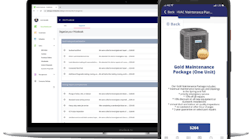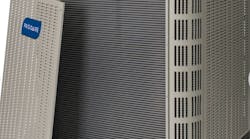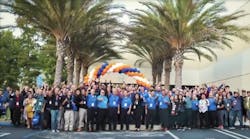Nortek Global HVAC
David LaGrand
CEO & President
Nortek Global HVAC is a global company, and business is not isolated to just North America. While the economy in North America is improving, that’s not true in some Latin American countries where we also do business. Europe also continues to be somewhat spotty. Our overall business is impacted by global conflicts and the financial stability of the countries in which we go to market. And, of course, we’re impacted by factors out of our control, like the cost of steel and copper and weather, which can be either positive or negative.
Additionally, we’re impacted by our channel partners and their plans for growth. Because the majority of our distribution is through independent wholesalers, we have to work hard to make sure we align with their goals and meet their needs, so we can grow with them.
In 2016, the biggest regulatory change will be the end of the sellthrough period for 13 SEER air conditioners in the South and most likely the discontinuation of dry charge units.
The regulatory world is swirling right now with new rulemakings. So many, in fact, we’ve had to staff up just to stay on top of them all.
In the short term, it becomes very difficult to innovate when your engineering and design resources are tied up addressing regulatory changes.
Also, as an industry, our product ranges are becoming narrower, giving consumers fewer choices – especially at the affordable bottom end. What is now a minimum-efficiency heat pump was high-end just 10 years ago. It’s a constant concern that the equipment will become so expensive that end-user demand will be negatively impacted. And again, this is not just in North America, but Europe as well. In fact, some of the regulations we are facing in Europe are preceding North America in the areas of efficiency, recyclability, refrigerants and emissions. In some cases, this demand in Europe might position us better in addressing North American regulations in the future – allowing better opportunities for our North American distributors to position “ahead of the curve” with our industry-leading products.
We have an engineering team dedicated to emerging technologies, especially in terms of controls. We have active projects addressing how our HVAC systems fit into the Smart Home – both for the homeowner’s convenience and also for the contractor’s benefit in troubleshooting and serviceability. We are also exploring monitoring packages for commercial customers wanting to cut energy costs across multiple sites.
For a very long time, HVAC systems were simple to install and troubleshoot. As the technology within the systems increased, the precision needed to work with the systems increased as well. One good example is our all-aluminum Micro-Channel evaporator and condenser coils. This coil technology is outstanding. It is lighter weight, delivers better heat transfer and requires less refrigerant – all while resisting formicary corrosion. But, for this technology to achieve optimum performance or to even work properly, it needs a precise refrigerant charge.
Contractors find they need to invest in better equipment and proper training. Change can be difficult within our industry, but as manufacturers redesign products to meet new technology (e.g., IoT (Internet of Things)) and regulatory needs, change is going to happen faster and more often than ever before.
Nortek Global HVAC has a robust training and education platform. Our technical team works with distributors to train in the field and also creates a vast library of on-demand video training. You can see some of that training at www.nordyneU.com. Additionally, we have a customer-only portal where we hold broadcasts for product launches, systems training (like our warranty system training) and marketing updates as well as “lunch and learns” in the spring and fall. Finally, we are in the process of adding technical FAQs to our online literature library and enhancing our online training platform. Our goal is to make HVAC training more accessible and more impactful to a greater number of HVAC contractors.
With our acquisition of Reznor in 2014, Nortek Global HVAC has a strong commercial product offering as well. Our biggest launch in 2016 will be variable-refrigerant flow (VRF) commercial equipment. It’s a global initiative, and we are launching in Latin America and Europe first, followed by North America in 2016.
On the residential side, we are launching ductless mini-split products in our Gibson brand. This will give our distributors a highly competitive ductless product. We hope to have those launched in conjunction with the VRF in early 2016. Additionally, we are introducing a direct exchange geothermal product line, which is designed to be highly efficient with a competitive installed cost.
Ferguson Enterprises
Alex Hutcherson
Vice President, HVAC
HVAC business trends with overall construction and the fundamentals for both commercial and residential construction look healthy. Residential starts are up 13 percent in 2015 after being up 9 percent in 2014, while commercial starts are up 10 percent and 5 percent over the same time periods. Multi-family construction should continue to lead as Baby Boomers look to downsize and Millennials continue to prefer urban apartments. However, as noted above, while multifamily will continue to be strong, single-family housing won’t be too far behind. Lending standards for mortgages have begun to ease and interest rates remain low, making it easier to justify the leap into home ownership, especially for first-time buyers.
On the replacement side of the business, the United States had highs in new housing starts from 2002 to early 2006. These homes are entering the range where HVAC repair and replacement will increase. This will bolster the opportunity for additional sales.
Global threats do exist both in Europe and in China, but the United States has a unique defense in the form of its domestic consumer base. Although threats abroad could spill over into the United States, the current situation isn’t a huge concern.
We won’t see as much in the way of regulation changes in 2015, but we will see the South and West enforcement of the 14 SEER regulation in 2016.
Looking forward, there will be new commercial efficiency standards in 2018, furnace fan standards in 2019, residential system efficiency in 2021 and commercial efficiency standards again in 2023.
In 2016, we will continue to see escalating costs and possibly supply shortages for R22.
HVAC contractors want easy access to products and the ability to order online in addition to the traditional purchase order (PO) process. Technology has made the distribution process more efficient and consistent through the use of warehouse management software, customer relationship management (CRM) software and various eBusiness solutions such as our customer transactional website Ferguson Online, mobile apps, scanners and barcodes, and dispensing machines and software. Ferguson recently released its own SKU barcode scanner app.
Nearly every aspect of the home has become smarter and more connected. Thanks to home automation technology, thermostats, cameras, door locks, kitchen appliances, lighting and TVs can all be monitored and controlled remotely. Most HVAC manufacturers offer Wi-Fi programmable thermostats that come with an array of benefits:
- Easily adjustable from any Internet- enabled smartphone, tablet or computer
- Sends alerts when the home environment changes drastically
- Provides information on how the system is performing with charts and graphs
- Climate adjustments can be scheduled up to seven dates in advance
As homeowners incorporate smart technology into their homes, they’ll need their HVAC contractors to execute proper installation of Wi-Fi programmable thermostats. This means more training for contractors and a better understanding of the technology. Ferguson offers HVAC technicians market-specific training opportunities on a variety of subjects so they can provide their customers with top-notch service and get fewer service callbacks.
Training opportunities vary by market and include:
- HVAC general knowledge training. Entry-level and intermediate HVAC training covers the basic innerworkings of an HVAC system, federal regulations from the EPA and DOE, and how to work with a distributor to order systems and repair parts.
- Brand-specific technical training. Manufacturers send trainers to a Ferguson HVAC location to update contractors on any improved technology, new installation procedures and how to troubleshoot and solve problems with an installed system.
- Mini split training. Ferguson offers in-class and hands-on training at mini split training centers where technicians can work with operational equipment by either Mitsubishi or Fujitsu. Technicians learn how the technology works and how to install, troubleshoot and repair a mini split system.
- Sales, business and customer service training. Some locations bring in trainers or third party companies to train contractors and technicians on sales strategies, customer service and business financials.
Trane
Jason Bingham
Vice President, Energy Services and Controls
Business owners should pay close attention to numerous economic factors that impact their company. Factors like market volatility, the upcoming presidential election and the rising cost of energy may be outside of a business owner’s control. However, there are strategies that businesses can implement in response to these factors. For example, evaluating the efficiency of heating, ventilation and air conditioning (HVAC) equipment, integrating smart controls and leveraging data from the existing building energy management system (BEMS) to create custom energy strategies can all significantly minimize the impact of energy costs to the bottom line.
Technology exists today that can provide the data business owners need to turn their building into an asset and help meet business goals.
It is a priority at Trane to design forward-thinking systems that meet the changing needs of buildings. From equipment control to building management, Trane’s priority is to streamline building operations to help our customers achieve their goals.
Technology has allowed for major shifts in traditional business as well as potentially disruptive innovations in the three- to five-year horizon – primarily around the combination of IoT, utility death spiral, small building innovation and energy/sustainability focus.
Remote based or web-based training is becoming more prevalent and will continue to grow in popularity. This type of education class is created to facilitate a long-term training session that allows participants to have an interactive learning experience from any location.
Web-based training is cost-effective for businesses because it eliminates the need for travel and lodging expenses that might otherwise be incurred from in-person training sessions.
Trane is working on connected equipment, IoT for building efficiency and next generation building energy management systems. In March 2015, Trane Air-Fi wireless technology was introduced. Air-Fi wireless technology is a reliable, flexible solution that eliminates the need for traditional wired systems for building controls, which allows for installations to be completed quickly and with less disruption. Air- Fi wireless technology helps optimize building performance and offers easy problem solving and cost savings over the life of the equipment.
John Mesenbrink has 17 years of experience writing articles about the mechanical trades. Also, he is CONTRACTOR magazine’s editor at large.











